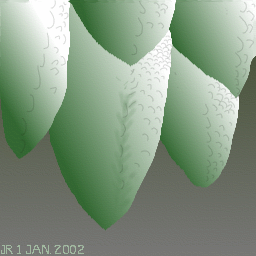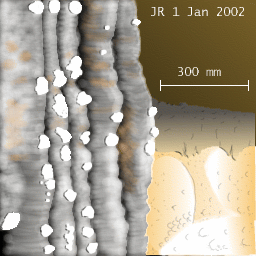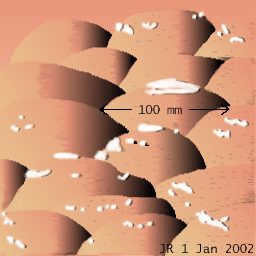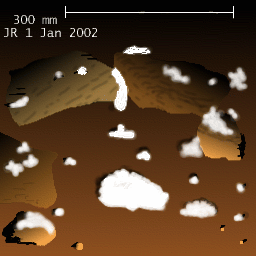This article is about deposits of moonmilk often seen in Eastern Australian caves.
| Contents |
|---|
| Introduction |
| Origin of Moonmilk |
| Tourist Do's and Don'ts |
| Discussion about thin wall coatings |
| Sharks Teeth Stalactites |
| Fluffy Stuff |
| "Potatoes" |
| References |
Introduction
Moonmilk is the term given to the white pasty material often seen coating walls and stalactites in caves. As a generic term, it gives no hint as to origin or composition. Moonmilk is found in many caves all over the world.In Australian caves, I have found moonmilk in some interesting forms as well as the usual coatings as follows:
- Thin wall coatings in an area of rockpile/breakdown in a cave at Jenolan (NSW). One sample has been tested by the Australian Museum and found to be mostly calcite with small quantities of magnesite, quartz and hydroxylapatite (R. Pogson, pers comm). Under the optical microscope it looks like a powder, with none of the clumping that one tends to observe with other forms of moonmilk. When a dried specimen is placed in water, it wets easily and the white powder simply sinks to the bottom as one would expect for powdered calcite.
- A white cheese-like pasty form found in the bottom of gour pools in another cave at Jenolan.
When touched, this deposit quivered almost like a curd or a jelly.
Each of the (dry) gour pools in this area had a different type of tower coral and
a different coloured moonmilk at the bottom, although each of the pools were
part of the same "streamway". Possibly they are fed from different roof drip points.
Colours ranged from white through to pale orange.
Other moonmilk deposits in this same cave include the familiar white coatings including a rather thick wall-niche deposit associated with aragonite anthodites and helictites. This latter deposit had been recorded as damaged by a person's hand print to at least 1 cm depth, yet 8 years later the print was no longer visible. This prompted some to question as to whether the moonmilk was "alive" or not. This particular material has not been analysed, but similar material from that cave was analysed by B. England and found to be calcite with a fibrous texture. The limestone bedrock is a hard silurian wackestone with dolomitised zones. - A stalactitic form which can be seen in the Chifley tourist cave at Jenolan. This form is fairly common in caves, both at Jenolan and elsewhere (eg Bats Ridge, Victoria).
- A cauliflower-like deposit, also in the Chifley Cave.
- An extensive thick deposit of "moonmilk" in the Chifley Cave glows a variety of colours (green, pink, blue) under short wave UV light. This has been tested by the Australian Museum and found to be mostly calcite with a number of phosphate minerals.
- A small stalactitic form that occurs near cave entrances and resembles sharks' teeth. This form is discussed below.
- A rather fluffy form that resembles fungus. This is also discussed below.
Origin of Moonmilk
Hill and Forti cite four main theories as to the origin of moonmilk:- Freezing in ice caves (does not explain tropical moonmilk).
- A by-product of the life cycle of various microorganisms (does not explain all occurrences of moonmilk)
- A disintegration product of bedrock (only explains one type of moonmilk)
- Precipitation from groundwater in which there is an agent which prevents the crystals from growing large. This is the theory preferred by Hill and Forti.
- Can freezing conditions cause moonmilk to deposit?
This is a report of a simple experiment performed at Jenolan Caves.
Tapwater at Jenolan Caves contains a high level of calcium and carbonate in solution.
It is pumped from the underground creek flowing through the caves and processed with
a UV light steriliser.
If Jenolan Caves tapwater is chilled in a container in a kitchen freezer,
the calcium carbonate precipitates
first as calcite rafts on the surface of the water.
They then may sink to the bottom of the container as calcite rafts.
The ice crystals form at the top of the container as would be expected.
The sunken calcite rafts do not look at all like moonmilk;
they are hard flakes, not a soft paste.
In a colder area, water freezing on the surface of a cave wall generally results in flakes of bedrock being dislodged due to ice crystal wedging, but this depends on the type of bedrock as to what type of disintegration occurs (see below). In mountainous areas, rock flakes due to frost wedging are common on the surface, and the flakes are not moonmilk. The grinding of rocks by glaciers produces rock flour, but this is made of fine pulverised rock and does not resemble moonmilk. Yet moonmilk does occur in icy caves. Perhaps it has nothing to do with the ice. - Is moonmilk due to the product of the life cycle of various microorganisms? Some is (see Phillips and Self). What seems to be happening is that calcite is deposited as a byproduct of microorganisms either as a coating over the microorganism (eg travertines), as a deposit inside the organism such as in tubes of fungal threads, or as a fairly conventional (mineral) deposit of crystals very close to the microorganisms.
- Is moonmilk due to a disintegration product of bedrock?
This of course depends on the type of bedrock, and what is
the substance causing it to disintegrate.
One common cause of bedrock disintegration is bat guano. The disintegrating substances in this case would be various nitrogen-based and phosphorous-based acids. These act not only on the bedrock but also on other speleothems and cave deposits, forming the multitude of bat-guano derived minerals. Some of these may have a moonmilk appearance. Also some of the acids may be quite weak, causing only part of the bedrock to be corroded and leaving larger grains and bioclasts in the bedrock untouched.
Other substances and causes of bedrock disintegration in caves may include:- The weathering of exposed pyrite in cave fill and bedrock to form hydrated iron oxides and sulphuric acid. This usually results in an absence of bedrock rather than a deposit of moonmilk.
- The precipitation of gypsum causing bedrock to wedge apart (crystal wedging); salt wedging by the precipitation of various other salts such as halite, nitre, etc in dry caves. This usually results in small bedrock flakes and dusts rather than moonmilk. One cave in which I was surveying (part of the Wollondilly tourist cave at Wombeyan, NSW) has an interesting fine calcite sand. This appears to be wedged from the low roof. The bedrock in this case is marble and the area was near a bat roost.
- Fault zone rock flour is quite distinct and again does not have the cottage cheese texture that the usual moonmilk has. It should be classified as "rock flour" in much the same way as glacial debris.
- Is moonmilk precipitated from groundwater in which the crystal size is
kept small?
- What if precipitation is rapid?
Rapid precipitation of substances will generally result in small crystal sizes.
This occurs near cave entrances where precipitation occurs
due to both outgassing CO2 and evaporation of water.
It also occurs where gypsum is being produced (common ion effect).
It does not explain the pasty types of moonmilk, and does not explain why stalagmites and stalactites formed in cave entrances are hard and crystalline and quite unlike moonmilk. Therefore I don't think rapid precipitation in itself is what causes moonmilk. - What if the calcite grains are prevented from touching one another?
This could occur if the grains were formed inside an organism (such as fungal
threads as is proposed by
Phillips and Self).
This could also occur in an organic fabric or colloid, such as in microbial veils.
It could also occur if the calcite was deposited as a by-product of
micro-organisms' activity as each calcite grain would be associated
with a specific set of microbes.
It should be kept in mind, however, that many microphotographs of moonmilk show that it is composed either of fine rods with a diagonal texture, or fine particles of calcite (sometimes hollow, skeletal crystals). This is difficult to produce from purely inorganic sources.
Calcite grains with a diagonal texture are common (eg in fossil bioclasts) however the texture is simply common pressure twinning. It is the rod-like aggregate that I am arguing has a biological source.
Further examples are shown in discussions on lublinite. - One way to decide whether the moonmilk is deposited as a result of organic activity would be to take some samples, verify that they are still depositing calcite in controlled conditions, then adding small quantities of various antimicrobial agents such as bleach, antiseptic solutions, etc and see if the activity stops.
- What if precipitation is rapid?
Rapid precipitation of substances will generally result in small crystal sizes.
This occurs near cave entrances where precipitation occurs
due to both outgassing CO2 and evaporation of water.
It also occurs where gypsum is being produced (common ion effect).
Tourist Do's and Don'ts
- Do look out for any interesting reflective dots on the moonmilk. You will only be able to see these with a light close to your eyes (eg a head mounted light).
- Don't go round poking the white material as it spoils its appearance for others.
- Note to tourist cave owners / operators: Be careful during cave cleaning operations. It is probably not a good idea to hose down areas of moonmilk as it is very soft and will wash off. It would be better to clean it with a vaccum cleaner without allowing the nozzle to touch the surface.
- Using a portable long wave UV lamp, look at the colours emitted by the moonmilk. You need to be dark adjusted to do this, and make sure that you don't look directly at the light from the lamp. These lamps are also sold as "black lights" for security use and for special effects. You should see different colours according to the different mineral and organic content. I have seen spectacular results with a short-wave UV lamp, however everyone should use eye protection and the short wave is harmful to organisms (it's a steriliser).
Discussion
Further notes about thin wall coatings
The thin deposits of white moonmilk associated with batty areas may be simply the results of
chemical action from guano on bedrock.
The zone of "moonmilk" appears to be only about 0,5 to 1 mm thickness and its substrate is
limestone bedrock.
It does not occur in well-washed areas (as it is easily washed off -
as I found when preparing samples).
It also occurs in areas in which cave fill (mud and gravel) has been deposited, and
again in these places it occurs more on the limestone bedrock and less on the fill. One of my samples of "moonmilk" deposited on clay
comprises major quartz, minor lepidolite, albite, kaolinite-1Md and aragonite.
In some areas it is associated with black deposits. A sample of this
white powder from a cave in the northern area of Jenolan was
analysed by Ross Pogson at
the Australian Museum using XRD and found to be mainly calcite with minor
quartz, very minor magnesite and minor hydroxylapatite.
The site is associated with dolomitised limestone, fault zone breccia,
bat guano, clay and aragonite speleothems.
Possibly what is happening is the lime mud in the bedrock is being corroded first, leaving small
bioclasts such as peloids and echinoderm fragments relatively intact.
Further notes about Sharks Teeth stalactites
This is a small stalactitic form that occurs near cave entrances and resembles sharks' teeth.
|
I have seen this form in a cave at Bats Ridge (Victoria) where the bedrock
is aeolian calcarenite.
It appears to be made of a mixture of moonmilk minerals and something with
chlorophyll, eg cyanobacteria.
The outer side of these little stalactites is greenish whereas the inner side is white.
The stalactites have a pronounced flatness as though to maximize the amount of light falling
on them.
Each "tooth" is about 1 cm wide, 2 cm long and about 5 mm thick at its base.
The "sharks' teeth" are deposited en echelon so as to form a stalactitic aggregate.
The cave also has large tray-like stalactites of moonmilk,
and dryish moonmilk covers most walls.
The sharks' teeth form clumps which look like normal stalactites from a distance. |

|
Possibly what is happening is this:
Aeolian calcarenite is a very porous rock made of grains of calcium carbonate and silica blown into
sand dunes and cemented. The ones at Bats Ridge are Pleistocene in age
(White, 1995).
The porosity of the rock allows seepage water to moisten a larger area of the cave roof than
would occur in harder, more consolidated limestone.
At Bats Ridge, most roof surfaces are covered in moonmilk to some extent.
White states that the moonmilk is needle form calcite, with a high moisture content between
the fibres.
In a large chamber in the cave, large (about 2 m long and 0,5 m wide) stalactites of moonmilk
occur, presumably at those parts of the roof with more seepage water than elsewhere.
The sharks teeth stalactites only occur near one of the cave's entrances on the sunny side.
One possibility considered was condensation of moist warm air at the entrance during the cooler months,
however this should
lead to forms seen in other caves and not specifically sharks teeth stalactites.
Maybe during the cooler months (winter is the wet season) there is more moisture available
to feed the moonmilk stalactites.
During summer, the sun passes higher overhead but in winter, the area where the sharks teeth stalactites
occur may be directly illuminated with the lower angled sunlight.
This would allow calcite to deposit more rapidly where the sunlight falls on wet areas of the sharks
teeth.
This is similar to the discussion regarding
crayback stalagmites and spelothems that appear to lean
towards the light.
The caves are relatively shallow and the roof of the cave is well within the
zone in which soil bacteria thrive. The vegetation above is sclerophyll, with Banksia
and low Eucalypt. Moisture content must be fairly high as leeches are a hazardous "feature" of the area.
Futher notes about Fluffy moonmilk
There are at least three occurrences of a rather fluffy variety of moonmilk which I have encountered in NSW caves.| Thin fluffy coatings | |
|---|---|
| In the Wollondilly (tourist) cave at Wombeyan Caves, there is a deposit of fluffy moonmilk covering one wall in an area called "The Loft" where there is at times a fair bit of air moving from one part of the cave to another. The deposit is about 5 mm depth and covers an area of about 3m high by 10m wide. It is developed on a mixture of sand and igneous rocks which have been washed into the (marble) cave. There is some evidence for an old bat guano deposit in the area, based on the corroded appearance of stalactites and stalagmites nearby. The deposit is mostly white, with patches of cream and light orange. In situ, the deposit glows bluish under long wave UV light. |

|
| "Potatoes" | |
|---|---|
| A similar kind of fluffy deposit occurs on the surface of hemispherical
deposits at Jenolan (NSW), locally called "potatoes" after the fancied
resemblance to the vegetable.
I first noticed this during the survey of a cave in the northern end of Jenolan.
A very small quantity of the fluff was rubbed between the fingers. Like other forms of moonmilk, it felt pasty like cottage cheese and nothing like fungus. I thought that it may have been made of the same material as the "potatoes", only the "potatoes" are older and more consolidated. This will be discussed separately in another article. |

|
Possibly the fluffy deposit is the active growing part of the hemispheres. Where this deposit is found, the cave is dry and the air is still although the humidity is high. I have seen examples of this form in several caves at Jenolan, including the showcaves (Lucas and Chifley), and in one cave at Wombeyan. In each case, it occurs with a suspected ancient bat guano deposit.
| "Fluffy Stuffite" | |
|---|---|
|
The unofficial name for the substance was coined by ANU student, Mr
I. McCulloch during a mineralogical survey of the Chifley cave with
members of the Australian Museum in 2000.
This most intriguing of the fluffy deposits at
Jenolan Caves occurs in the Wilkinson
Branch of the Chifley (show) Cave at Jenolan.
In 1899, John Mingaye (chemical analyst for the NSW Goverment Department of Mines and Agriculture) analysed a sample of this material. He wrote: Two samples of this substance were received. The first, which weighed 1½ grammes, Guide Wyburd states, "was compressed into a small match-box, and would fill your hat in its natural state." |

|
"It is so light that, when you blow at it, it falls off the roof and sides like snow." It is stated to occur in one cave only - that is, at the end of the Wilkinson Cave. The fungoid growth appears to be very rapid, for since the sample was received it formed in large quantities, and has the appearance of very fine wadding.
The analysis showed the bulk of the material to be calcium carbonate (72-76%),
silica (13-17%), magnesium carbonate (5-6%) and small quantities (around 1%) of moisture,
alumina, ferric oxide, organic matter. There were traces of strontium
carbonate and phosphate.
There does not appear to be hatfuls of the material presently in the Chifley
Cave, however the material that I have been shown is certainly not dense.
Maybe its development is seasonal.
Some of it has been analysed recently by the Australian Museum and was found to
be mostly calcite and a small quantity of silica as quartz.
The analysis did not indicate what form the calcite took, i.e.
whether it was needle form calcite, fine crystalline calcite or
other form.
The material that I saw took the form as sketched in the figure,
with some as a loose ball on the soil, other blobs in
nooks between rocks and other pieces on top of rocks.
This part of the cave is relatively dry, although vermiculations
under some of the roof boulders would indicate that at times
it can get damp.
The air is still and humid.
Possibly the material is formed from a similar substrate to the "potatoes", i.e.
a very old guano pile mixed with silt and kept moist with lime-rich seepage
water. I suspect there is a little ecosystem of soil microbes involved, keeping the
calcite together as a thatch of light fluffy form,
with kaolin nearby in the cave acting as a moisture stabiliser.
It would be interesting to investigate this further.
References
Some brief reviews are included with the references.
-
In Hill & Forti,
over 35 sub-topics discuss moonmilk.
As a speleothem, moonmilk is described as "soft, plastic and
pasty wen wet, but crumbly and powdery when dry".
Moonmilk is not a mineral; it is a speleothem.
It is usually composed of carbonate minerals but may also be
composed of sulphates (eg gypsum), phosphates, silicates and other minerals.
Carbonate minerals include calcite, aragonite, vaterite, hydromagnesite,
huntite, nesquehonite, magneite, dolomite, monohydrocalcite,
hydrozincite, both singly or in combination.
Varieties of subaerial moonmilk are described and several theories of formation are discussed including both biological and non-biological origins. Medicinal aspects are discussed. Varieties of subaqueous moonmilk are similarly described. There are over a dozen photographs of various sorts of moonmilk.
The special topic on Microorganisms and Speleothems discusses moonmilk formed in some cases by biochemical corrosion of bedrock and in other cases precipitation of moonmilk by bacteria. - In "Speleology" by George Moore and Nicholas Sullivan, the influence of microorganisms on the development of moonmilk is discussed. In cold caves, the main mineral present in moonmilk is calcite. In warmer caves, magnesium minerals may be present such as hydromagnesite, huntite, nesquehonite and dolomite. Microorganisms listed include algae, actinomycetes and the bacterium Macromonas bipunctata. SEM photos give views of different types of moonmilk. A TEM photo shows what is assumed to be a calcite-depositing organic body. The diagonal nature of the calcite rods is discussed and a mechanism for growth is postulated. A brief history is given for the uses of moonmilk in medicine.
-
Hans Fischer, 1988.
"Etymology, Terminology and an attempt of definition of Mondmilch."
The NSS Bulletin, Vol 50 No 2 December 1988 pp 54-58.
Fischer discusses the history and usage of the various names given to Moonmilk. He includes an XRD spectrum of Mondmilch from the type locality of Mondmilchloch at Pilatus, Switzerland, as well as thin section and SEM photographs. Fischer insists that mondmilch is the term given to white pasty masses of calcite (90%) and the term moonmilk should be used for any similar material which has not been properly analysed. A table is included of synonyms of mondmilch in various languages. -
John C. H. Mingaye, F.C.S. Analyst, 1899.
"On the occurrence of phosphatic deposits in the Jenolan Caves, New South Wales"
Records of the Geological Survey of New South Wales,
Vol VI, Part 2, April 1899 pp 111-116.
Mingaye analyses several samples from the Jenolan Caves. The geology is introduced with a quote from Professor David. Chemical analyses are then given for the following samples:- "Reddish Marl" from the Devils Coach House
- "Light, porous friable substance" from Katies Bower, Left Imperial Cave
- A deposit from the floor of the Grotto Cave
- "Light fluffy fungoid substance found in the Fairy's Grotto, Wilkinson Cave, Left Imperial"
- "White pulvurent substance found in the Left and Right Imperial Caves"
- "White saline substance" from the Devils Coach House
- "Greyish pulvurent substance" from one of the caves
-
"Morphology, Crystallography and Origin of Needle-fibre Calcite in Quaternary Pedogenic Calcretes of South Australia"
by
Phillips, S.E. and Self, P.G.
Australian Journal of Soil Research,
1987,
Vol. 25,
No 1,
pp 429-444
Needle-fibre calcite is called lublinite. The article shows how it is formed around fungal threads in the soil in areas with high soil calcite content. SEM photos show en-echelon development of calcite crystals, with some interesting forms of calcite. - "Quaternary Limestone Areas of Western Victoria" by Susan White in: Vulcon Guidebook: Lava features and Limestone Karst of Victoria and South-Eastern South Australia, 1995, Glenn Baddely (editor). Australian Speleological Federation, Inc., Hamilton, Victoria 1995 pp 81-98.
- Analysis of Samples by Brian England in: Newcaves Chronicles, Vol 15, July 2000, p 23-24 published by the Newcastle and Hunter Valley Speleological Society. ISSN 1325-0930.
Cosmetic update September 2025. Originally written January 2002, updated 17th February 2006.